Artificial Intelligence is reshaping nearly every industry, and crypto is no exception. The best AI cryptos of 2025 go beyond hype, offering real infrastructure for compute, data sharing, and decentralized intelligence. From networks that power on-chain machine learning to tokens enabling AI-driven applications, these projects sit at the center of two transformative technologies.
Table of Contents
Why 2025 Is a Pivotal Year for AI in Crypto
2025 is shaping up to be a defining year for AI in the crypto world. Institutional interest in AI-focused blockchain projects has grown sharply, supported by clearer regulations and major advances in decentralized infrastructure. Platforms that once served as general-purpose blockchains are now being reimagined as the backbone for machine intelligence—systems where AI models can verify, transact, and coordinate without centralized control.
Industry analysts note that blockchain is increasingly viewed as the audit layer for autonomous AI systems, ensuring transparency and trust in decision-making. At the same time, the global AI boom is fueling huge demand for decentralized compute, storage, and data-sharing frameworks—the very things crypto networks are built to deliver. As AI becomes more deeply woven into the digital economy, 2025 could mark the moment when blockchain moves from supporting speculation to powering the next generation of intelligent, autonomous systems.
Top AI Infrastructure Altcoins to Watch
Below are seven standout projects positioned at the intersection of AI and crypto infrastructure.
1. Bittensor (TAO)
Bittensor is a decentralized AI infrastructure network that uses its native token, TAO, to incentivize contributors—miners, validators and delegators—who provide compute, model training, and validation for machine-learning sub-networks (subnets). The protocol ties token issuance to subnet performance rather than fixed rewards, aligning incentives around real-world utility.
Why It Could Go Up
- In October 2025, TAO gained momentum after the filing of a Form 10 by Grayscale for a Bittensor Trust, which would enable a regulated investment vehicle for TAO.
- The resolution of a $28 million hack investigation gave investors a confidence boost, sparking fresh inflows into TAO.
- With the halving in December on the horizon, the market is anticipating lower token issuance and stronger staking demand, both of which support a bullish case.
2. Render (RNDR)
Render is a decentralized computer network that connects those needing GPU power for rendering and AI training with idle GPU operators who earn RNDR tokens in return. The protocol originally focused on 3D rendering—turning idle hardware into a distributed rendering engine—and has since expanded into AI-inference and creative-application workflows.
Why It Could Go Up
- In July 2025 Render launched a decentralized bounty platform to reward community contributions with RENDER tokens, helping build tooling, ecosystems and dev-participation.
- As demand for GPU compute soars (driven by generative-AI models and 3D immersive media), Render’s model of “compute as a service” places RNDR in the infrastructure layer rather than just another token.
- As of October 2025, RNDR became available to German users on Coinbase Global, expanding its investor base and raising awareness in European markets.
Learn how to spot scams and protect your crypto with our free checklist.

3. Fetch.ai (FET)
Fetch.ai is a decentralized AI-blockchain platform that enables the development, deployment and operation of autonomous economic agents (AEAs)—software programs that can negotiate, transact and learn on behalf of humans or machines. These agents run on the Fetch.ai network, where the native token FET is used to register agents, pay for services, and participate in network governance.
Originally founded in 2017 and launched via an IEO in 2019, Fetch.ai works with applications such as supply-chain logistics, energy-grid optimization, mobility services and decentralized finance.
Why It Could Go Up
- A recent academic paper presents Fetch.ai’s stack as a mature multi-agent system bridging classical MAS research with blockchain infrastructure: a strong technical endorsement of the platform’s under-the-radar utility.
- The public dispute between Fetch.ai’s CEO and the Ocean Protocol team (Oct 2025) has brought FET into the spotlight, increasing social engagement and awareness among token-holders.
- Amid the broader rush for AI infrastructure, Fetch.ai’s focus on agent-based frameworks and decentralized coordination gives it a differentiated story compared to mere “AI token hype” plays. This has started to attract developer interest and media coverage.
4. Ocean Protocol (OCEAN)
Ocean Protocol is a decentralized data-exchange infrastructure designed to enable individuals and organizations to monetize, share, and license datasets while retaining privacy and control. Ocean uses features like Data NFTs (ERC-721) and “datatokens” (ERC-20) to represent data assets and access rights, and offers a Compute-to-Data model where algorithms can run on the data without the data ever being exposed.
The native token OCEAN serves for governance, staking/curation, marketplace payments, and network incentives.
Why It Could Go Up
- As AI models demand ever-more high-quality and diverse datasets, platforms like Ocean are becoming increasingly relevant. The notion of unlocking “data for AI” (rather than hoarding it) resonates in the current cycle and gives OCEAN a strong narrative.
- Recently, Ocean Protocol’s unexpected exit from the Artificial Superintelligence Alliance (ASI) and subsequent on-chain allegations have driven increased visibility… though not all of it is positive. Still, any attention could always be good for crypto projects.
- Given the scrutiny, any steps toward improved governance, clarifying token-flow transparency, or strategic partnerships around the data-economy could act as a re-entry point for investors monitoring OCEAN’s infrastructure narrative.
5. Internet Computer (ICP)
Internet Computer (ICP) is a Layer 1 blockchain designed to function as a global “world computer,” allowing developers to build full-stack web applications, smart contracts, and decentralized services without relying on centralized cloud providers. It enables artificial intelligence models and inference to run directly on-chain rather than through external infrastructure.
The project’s roadmap highlights its Chain Fusion technology, which connects ICP with major blockchains such as Bitcoin and Solana to create a multi-chain execution environment.
Why It Could Go Up
- According to its roadmap, ICP has already deployed key phases such as “Vertex” (Caffeine AI platform) and is targeting “Meridian” (Dogecoin integration) in October 2025. These real milestones strengthen its utility narrative.
- KuCoin lists ICP as one of the top DePIN (decentralized physical infrastructure) projects in October 2025.
- The ability to host full applications (front-end, back-end, storage) in a decentralized manner, with lowered friction via “Internet Identity” upgrades, gives ICP unique positioning among other Layer 1s.
6. The Graph (GRT)
The Graph is a decentralized protocol designed for indexing and querying blockchain data, enabling developers to build scalable Web3 applications without managing complex infrastructure. The network lets users create “subgraphs”—open APIs that define how blockchain data is structured and accessed—and the native token GRT is used in governance, staking, and fee-settlement roles.
Why It Could Go Up
- On October 9 2025, Grayscale added GRT to its Decentralized AI Fund, allocating around 6.2 % to the token and signalling growing awareness of The Graph within regulated investing vehicles.
- In Q2 2025, query volume on The Graph’s network hit a new high (6.49 billion queries) and active subgraphs increased ~13 % quarter-over-quarter, pointing to rising developer adoption and broader ecosystem use.
- As AI applications and agents become increasingly popular, the need for reliable indexed blockchain data will continue to grow. The Graph’s role as a “data layer for Web3” elevates its relevance in the AI-crypto infrastructure theme.
7. NEAR Protocol (NEAR)
NEAR Protocol is a Layer 1, sharded proof-of-stake blockchain focused on scalability, usability and developer experience. It uses a sharding design known as “Nightshade” to enable high throughput and lower fees, and supports WebAssembly (WASM) smart contracts so developers can code in familiar languages like Rust or AssemblyScript.
The platform aims to act as a “blockchain for everyone” with user-friendly features such as named accounts and seamless onboarding. Also, NEAR has been positioning itself towards cross-chain interoperability and AI integration, supporting the idea of on-chain intelligent agents interacting across Web2 and Web3 environments.
Why It Could Go Up
- In October 2025, the NEAR governance community proposed reducing maximum inflation to 2.5% and increasing rewards for locked veNEAR tokens under the “House of Stake” initiative. This change signals more scarcity and stronger alignment of incentives.
- NEAR’s “Intents” and bridge technologies are connecting the protocol with 20+ different blockchains, enhancing its multi-chain utility and network effects.
- By focusing on intelligent agents and scalable decentralized apps, NEAR is becoming one of the more talked-about projects in the AI-Web3 space this year.
Final Words
AI-driven crypto projects are evolving fast, bridging the gap between digital assets and intelligent automation. Whether it’s decentralized compute from Render, data sharing through Ocean Protocol, or agent-based networks like Fetch.ai, each plays a unique role in building the foundation for AI on-chain. Still, this space remains highly experimental—so research carefully, stay updated on project roadmaps, and diversify where possible. If 2025 delivers on its promise, these AI infrastructure tokens could shape the next era of Web3 innovation.
Disclaimer: Please note that the contents of this article are not financial or investing advice. The information provided in this article is the author’s opinion only and should not be considered as offering trading or investing recommendations. We do not make any warranties about the completeness, reliability and accuracy of this information. The cryptocurrency market suffers from high volatility and occasional arbitrary movements. Any investor, trader, or regular crypto users should research multiple viewpoints and be familiar with all local regulations before committing to an investment.

